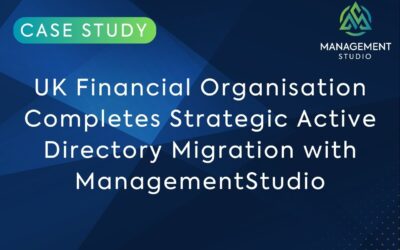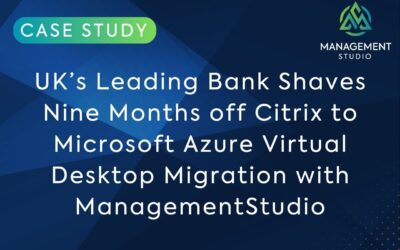Welcome to the second instalment of our series focusing on our transformation methodology. This one looks at Control. So, what so we mean by control? Well, data without context, is just data – right? We have talked in our previous blog about how we Capture data that is pertinent to a transformation programme. Data about users, apps, devices, locations, departmental and contact information are easily ingested into ManagementStudio via connectors and other import methods, typically daily. We then add context to this data by locking in the relationship between all those sources of data. This means that we can easily show the home-based users in the Procurement department who have used the VDI estate in the last 10 days. Or the devices used in New York which can be upgraded to Windows 11. And why are certain devices not suitable for that new OS?
Now we have that data, we have the context, we have the control over that data. What can we do now?
You are now at the stage where you have the framework to start shaping your programme and create highly efficient workflows and deploy automation that reduces resource and improves the end-user experience. In this blog, we will take a closer look at the following areas:
- Enhanced Reporting: gives project managers the information they need to track progress and identify bottlenecks
- Data Mining: Deep dive into data regardless of its originating source to understand a resource’s place within the project and explore links to other resources.
- Workflow: Create structured workflow and processes that influence decision making.
- Automation: Automate manual activities to help reduce timescales and cost whilst improving end-user experience.
- Auditing: Accountability encourages people to value their work and builds confidence within the team.
- Blueprints: Structure and shape the project and its data in a way that makes sense to your organisation.
Enhanced Reporting
We have talked previously about doing away with disparate spreadsheets and manual processes in favour of using a central repository like ManagementStudio for all the pertinent data required for transformation programmes. Well, having all that data is great, but you need to be able to present it in a way that works for everyone.
ManagementStudio’s dashboards provide organisations with an extensive array of views that highlights exactly how the project is progressing, where things currently stand and what is required to keep the momentum and what possible bottlenecks or delays might be around the corner. We have built-in reports which are fully customisable and can be scheduled to send to all the appropriate stakeholders on a daily, weekly, or monthly basis. Alternatively, you can create your own, bespoke reports.
PowerBI
We can take reporting a stage further as well! We fully support Microsoft’s PowerBI which enables the project team to create reports containing metrics from ManagementStudio side-by-side with data from other systems.
Data Mining
There is an abundance of data that we collect over time, and wouldn’t it be great if you could drill down, in detail, through multiple layers of that data and create reports that can be sent to team members. Well, that is exactly what our data mining reports do.
Imagine the scenario where you want to identify all the users in the Shanghai office, that are being upgraded to Windows 11 next that are using Adobe reader. We can easily do that, and what’s more, send a link to that report via email to the relevant people.
Each and every field is accessible through a Data Mining Report and can be layered with other modules to create a complex query. Results are filtered by expressions and conditional statements to easily focus on the information that is important. And if that’s not enough, reports are incredibly easy to share with other ManagementStudio users.
Workflow
ManagementStudio allows for structured processes to be applied to all the of the data we ingest. This means we can follow or track that data throughout the transformation process. This helps with decision making processes and allows for automation to help accelerate the programme by triggering events to happen once the data is moved to a certain process. This could be something like sending emails to users once they are ready to be migrated.
Every module within ManagementStudio has its own list of processes and sub-processes that can be tailored to match those of your organisation. This gives you unprecedented control over the data and how it moves through the business.
Automation
We introduced automation back in 2019 and it has proved invaluable from the outset and has been continuously developed and improved. It is now fully integrated into ManagementStudio and is at the core of our methodology. We use “If this, then that” as the basis of our automated decision making. We call these service plans, and they can be applied to anything that is contained within our database. So as applications, users, devices etc move through the transformation process, automation can take place based on certain condition. We have three main types of events.
- Triggered Events are invoked when a user performs a certain action, e.g., the user is automatically moved to a new process once they submit a survey
- Conditional ‘if this then that’ statements allow you to deploy automation to cater for specific scenarios, such as inviting users to book their upgrade once all their applications are ready to be deployed
- Scheduled events are performed at a specified point to help with routine activities, like sending a satisfaction survey to all users that were migrated a week ago
Automation reduces human error and can rapidly accelerate processes that would previously have been completed by individuals. Our automation is API powered so we can trigger other systems, so if a user is showing as ready to be migrated, they can automatically be dropped into Active Directory groups on SCCM/MECM collections. This means that users on the other side of the world can be migrated automatically whilst you are asleep.
Auditing
ManagementStudio tracks all changes and actions made to every record in the tool. This level of auditing is invaluable for generating change history reports and understanding how a record has evolved throughout its life within the database. It empowers teams to value their work and provides the level of visibility to ask questions like:
- How many applications entered testing last month?
- When was the self-schedule email sent, was it opened and when?
- What event caused a particular application to change and who actioned it?
Blueprints
We use a concept of Blueprints to re-create the business structure in a way that suits the transformation. This can be based on information that comes in from Active Directory or an HR import or it can also be structured exactly how you want, but it means you can look at the data in way you would like without changing the actual information that has been imported. This information can be structured as below:
- Organisational structure
- Geography
- Business unit
- Directorate
- Building
- Sprints
This allows you to quickly model scenarios like, “show me all users in the London office that work in Finance”.
Blueprints are also used to define departmental “app stacks” which automatically link applications to a user when joins that department. Likewise, the application links are removed if the user moves to a different department.
Controlling the data like this gives an organisation unparalleled knowledge and power when shaping the direction of travel of their programmes. The ability to see the entire estate landscape in a single view has not been possible previously and can extend well beyond those one-off migration projects and can broaden into business as usual (BAU) so, for example, managing the ongoing OS updates from Microsoft, being ready for Windows 11, migrating mailboxes or even server migrations. The data is there, under control and ready to help.
The next instalment will focus on Communicate, where we will talk about automated user communication such as surveys, questionnaires and t-minus emails.



